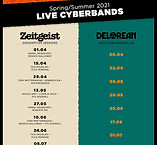
OUR STORY
The week before the pandemic hit the UK in March 2020, I started work on the problem of how to bring people together online, in a meaningful way, through music. It's especially true now, after the few years we've all had, that live music through a screen is no substitute. Of course it's not. StreamCycle was never meant to be a substitute for 'the real thing'. But its true that it can be an interesting and entertaining alternative. The main problem with bringing people together to play music online, as most of us know by now, is latency. Latency is the time it takes for an audio or video digital signal to travel across the internet and back. So, in a conference call for instance, when one personal plays a chord... it travels to the next person... they hear it and play along... and it travels back. By this time maybe half a second has elapsed and the music sounds horrifically out of time. Essentially, players can't play at the same time. Yes, there are great technologies out there which focus on low-latency music collaboration, but they're not ready yet, and they're exclusive ie. participants need to be fairly close in distance, and have a relatively advanced technological setup with super fast internet speeds. The more I learned about latency in those first weeks, the more I realised I would need to come at the problem from a different angle... by embracing the latency. So, at the beginning of May 2020, we trialed the first model on Facebook Live. Here's how it worked: Player 1 takes part on their mobile device by going live into a private Facebook group. They're in Position 1, and give their performance as they would a normal solo livestream. It takes a massive 12 - 20 seconds for their live video to reach Position 2, viewing the live video in the private group. It is then captured 'live' and streamed out again to the public using the free live streaming software OBS, Open Broadcast Software. At the same, the player in position 2 captures their own live performance in real time and inserts it into their live video so that when it reaches the public, their performances are combined into a duo, side by side, and in sync. The process is then repeated a second time, a third, a fourth... by the time our first model became obsolete, we managed to layer up 7 live musicians across the globe in this way. But for what? What was the point? Why all the effort? The point is to engage and create with other musicians with the zeitgeist of the times we live in; to connect with audiences, friends and family by providing them with a form of live entertainment that has previously never been seen in the world; to stand up the affects that COVID 19 has had on our industry; to dig our heels in as artists and say, "We will not be beaten"; to solve the problem of latency by making it meaningless. In December 2020 we performed our final live streamed concert with StreamCycle Mark I. After this, a team of musicians connected from across the globe began integrating and testing our new model. With Mark II, at the push of button, we were able to switch between real-time communication (Chat Mode) and layered-up live-overdubbing (Music Mode). With Mark II, we were only streaming audio to each other which means the CPU processing was much more manageable for all players - remember everyone is taking part at home with what equipment they happen to have at hand. We used a 7.1 surround signal to channel the separate feeds in individual lanes, which means we could fully mix the music at the end of the chain before it got streamed out to the public. All video was delayed according to each individual player's positions, so there was no need to layer it up. In a nutshell - it was slicker, easier, stronger, it looked better, it sounded better. Then, after a lengthy programme of succesful Mark II gigs, StreamCycle headed back into the lab to develop Mark III. We've taking the problems and puzzles that Mark II posed about making music in this way and we figured them out. In the future it's now possible to improve audio/video quality even further, be able to incorporate up to 18 players (possibly more), in live collaboration..... and we finally figured out how to nail the audio/video 'sync'. Watch this space....













